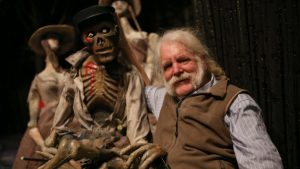Originally published on Playbill.com as part of the “Outside the Theatre” series.
Bob Flanagan, who has been making puppets since the “glory days,” chats about his latest project: Irish Rep’s The Emperor Jones.

Bob Flanagan has been making puppets since the “glory days” of puppetry—working alongside Jim Henson making secondary and background characters for the Muppets and Sesame Street—as well as 27 seasons of Saturday Night Live. His latest project, with frequent collaborator director Ciarán O’Reilly, is the Irish Repertory revival of Eugene O’Neill’s haunting drama, The Emperor Jones.
Said to have roots in O’Neill’s own hallucinatory experience exploring the jungle in Honduras, the play tells the story of Brutus Jones, who crowns himself as monarch of a Caribbean island and descends into terrifying, psychological darkness—haunted by the ghosts of his past, all the while striving for salvation. For the Off-Broadway staging, Flanagan has created life-sized, back-from-the-dead Southern Belles, a dice-rolling skeleton, and a miniature slave auction, among several other props and puppets.

Tell me about the world you’ve helped create onstage.
I was blown away by the script. The Emperor Jones’ travels are very Jungian—back to his collective unconsciousness—and we’re not quite sure if the images are real or not. It feels like somebody’s nightmare. There were so many bizarre and wonderful tableaux—like the trees coming to life—and I started drawing as soon as I read it. It was very organic. Like you would catch these images out of the corner of your eye if you were walking through the forest.
So do you always sketch as soon as you’ve read the script?
With this show, in particular, there was such great imagery that I started sketching straight away.
When you start intuitively sketching like that, are you thinking about logistics?
I get an image in my mind of what I’d like to see onstage. I may think about logistics—it’s always at the back of my mind being a puppet builder and knowing what we can and can’t do—but more so, I go for the general feel of what I’d like to get across onstage.
Who builds the puppets?
I did most of the sculpts for these puppets and I have a team of four or five that helped with mold-making and costume-making.
What are the sculpts made of?
Earth clay. So we make a mold and cast them in carbon fiber to keep them very lightweight.
What kinds of materials do you like to work with?
Anything that works! I’ve used various food stuffs—like cream of wheat as a thickener. We use anything we can get to make a visual statement onstage.
What can a puppet bring to a theatrical production that an actor cannot?
Technically, puppets can do a lot—they can defy gravity. In this production, there is a hypnotic quality to the puppets, which reels the audience in. Take the Southern Belles for example—you wouldn’t be able to get that same feel from an actor in a costume.

What about their movement onstage?
Movement is really important and you want to make the puppets as expressive as possible. There’s also a shorthand with their movements; even the slightest hand gesture, or a tilt of the head can speak volumes that actors or lines can’t always get across.
How closely do you work with actors on a show?
It depends on the production. With Emperor Jones, the choreographer [Barry McNabb] has mainly been working with the actors and done a lot of the puppet work.
You have such a rich background in puppetry and you still work at SNL. What do you do there?
I design and perform the puppets, and I build weird props and costumes—I’ve made a lot of Justin Timberlake’s costumes, Toonces the car-driving cat, and the falconer. It depends on what they need from week to week, and not everything that I make gets used. As with all live television, they change it up until the last minute, even between the last dress rehearsal and going to air.
Do you enjoy that kind of pace?
I do. There’s never a dull moment and it stretches you. Once, SNL called on a Wednesday night at around 10 PM and said: “We need two live-sized camel puppets.” You say, “Sure,” and then think, “What the hell did I just agree to?” It’s nerve-racking and there isn’t too much sleep that happens in between.